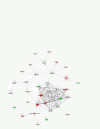Systems biology discoveries using non-human primate pluripotent stem and germ cells: novel gene and genomic imprinting interactions as well as unique expression patterns
- PMID: 20699013
- PMCID: PMC2941116
- DOI: 10.1186/scrt24
Systems biology discoveries using non-human primate pluripotent stem and germ cells: novel gene and genomic imprinting interactions as well as unique expression patterns
Abstract
The study of pluripotent stem cells has generated much interest in both biology and medicine. Understanding the fundamentals of biological decisions, including what permits a cell to maintain pluripotency, that is, its ability to self-renew and thereby remain immortal, or to differentiate into multiple types of cells, is of profound importance. For clinical applications, pluripotent cells, including both embryonic stem cells and adult stem cells, have been proposed for cell replacement therapy for a number of human diseases and disorders, including Alzheimer's, Parkinson's, spinal cord injury and diabetes. One challenge in their usage for such therapies is understanding the mechanisms that allow the maintenance of pluripotency and controlling the specific differentiation into required functional target cells. Because of regulatory restrictions and biological feasibilities, there are many crucial investigations that are just impossible to perform using pluripotent stem cells (PSCs) from humans (for example, direct comparisons among panels of inbred embryonic stem cells from prime embryos obtained from pedigreed and fertile donors; genomic analysis of parent versus progeny PSCs and their identical differentiated tissues; intraspecific chimera analyses for pluripotency testing; and so on). However, PSCs from nonhuman primates are being investigated to bridge these knowledge gaps between discoveries in mice and vital information necessary for appropriate clinical evaluations. In this review, we consider the mRNAs and novel genes with unique expression and imprinting patterns that were discovered using systems biology approaches with primate pluripotent stem and germ cells.
Figures


Similar articles
-
Tbx3 improves the germ-line competency of induced pluripotent stem cells.Nature. 2010 Feb 25;463(7284):1096-100. doi: 10.1038/nature08735. Epub 2010 Feb 7. Nature. 2010. PMID: 20139965 Free PMC article.
-
Human-induced pluripotent stem cells produced under xeno-free conditions.Stem Cells Dev. 2010 Aug;19(8):1221-9. doi: 10.1089/scd.2009.0459. Stem Cells Dev. 2010. PMID: 20030562
-
Efficient Reprogramming of Canine Peripheral Blood Mononuclear Cells into Induced Pluripotent Stem Cells.Stem Cells Dev. 2021 Jan 15;30(2):79-90. doi: 10.1089/scd.2020.0084. Epub 2020 Dec 24. Stem Cells Dev. 2021. PMID: 33256572
-
The genetics of induced pluripotency.Reproduction. 2010 Jan;139(1):35-44. doi: 10.1530/REP-09-0024. Reproduction. 2010. PMID: 19605512 Review.
-
Mediators of induced pluripotency and their role in cancer cells - current scientific knowledge and future perspectives.Biotechnol J. 2012 Jun;7(6):810-21. doi: 10.1002/biot.201100347. Epub 2012 May 16. Biotechnol J. 2012. PMID: 22589234 Review.
Cited by
-
Ex vivo reconstitution of arterial endothelium by embryonic stem cell-derived endothelial progenitor cells in baboons.Stem Cells Dev. 2013 Feb 15;22(4):631-42. doi: 10.1089/scd.2012.0313. Epub 2012 Oct 10. Stem Cells Dev. 2013. PMID: 22931470 Free PMC article.
-
The production of glial cell line-derived neurotrophic factor by human sertoli cells is substantially reduced in sertoli cell-only testes.Hum Reprod. 2017 May 1;32(5):1108-1117. doi: 10.1093/humrep/dex061. Hum Reprod. 2017. PMID: 28369535 Free PMC article.
-
NFE2L3 (NRF3): the Cinderella of the Cap'n'Collar transcription factors.Cell Mol Life Sci. 2011 Oct;68(20):3337-48. doi: 10.1007/s00018-011-0747-x. Epub 2011 Jun 18. Cell Mol Life Sci. 2011. PMID: 21687990 Free PMC article. Review.
-
Systems and Network Pharmacology Approaches to Cancer Stem Cells Research and Therapy.J Stem Cell Res Ther. 2012 Dec 16;Suppl 7(5):10413. doi: 10.4172/2157-7633.S7-005. J Stem Cell Res Ther. 2012. PMID: 24319631 Free PMC article.
-
Multi-Omics Analysis of Molecular Characteristics and Carcinogenic Effect of NFE2L3 in Pan-Cancer.Front Genet. 2022 Jun 29;13:916973. doi: 10.3389/fgene.2022.916973. eCollection 2022. Front Genet. 2022. PMID: 35846126 Free PMC article.
References
-
- Ben-Yehudah A, Navara CS, Redinger CJ, Mich-Basso JD, Castro CA, Oliver S, Chensny LJ, Richards TJ, Kaminski N, Schatten G. Pluripotency genes overexpressed in primate embryonic stem cells are localized on homologues of human chromosomes 16, 17, 19, and X. Stem Cell Res. 2010;4:25–37. doi: 10.1016/j.scr.2009.09.003. - DOI - PMC - PubMed
-
- Bhattacharya B, Cai J, Luo Y, Miura T, Mejido J, Brimble SN, Zeng X, Schulz TC, Rao MS, Puri RK. Comparison of the gene expression profile of undifferentiated human embryonic stem cell lines and differentiating embryoid bodies. BMC Dev Biol. 2005;5:22. doi: 10.1186/1471-213X-5-22. - DOI - PMC - PubMed
Publication types
MeSH terms
Substances
Grants and funding
LinkOut - more resources
Full Text Sources
Research Materials

